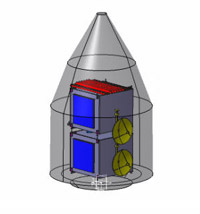






High Hopes for Don Quijote
By Robert Gounley
Just what makes that little ole ant Think he'll move that rubber tree plant? Anyone knows an ant can't Move a rubber tree plant But he's got hi-i-igh hopes, he's got hi-i-igh hopes He's got high apple pi-i-ie-in-the-sk-y-y hopesLyrics of High Hopes By Sammy Cahn and Jimmy Van Heusen.
Optimists kick-started the Space Age. The talent was already there, but it needed leaders with confidence and conviction. The generation coming of age in the late 50s and early sixties provided them. Their anthem was a bouncy little ditty sung by Frank Sinatra called High Hopes. The song perfectly suited its age. Never mind life's little annoyances, like those pesky Russians launching satellites over our heads. With pluck and stick-to-itiveness, any problem can be overcome. Optimism made hard work worthwhile. Hard work produced results.
 |
| Don Quijote in Launch Configuration inside Soyuz Fairing. ESA drawing. |
Times have changed. The public has, in large measure grown distrustful of technology to solve major problems. To cynics, space is less about sending things up than watching things come down. Near-Earth asteroids regularly pass by our planet. What, they ask, are we going to do when one pays us a courtesy call?
Mankind is ill-prepared for such courtesy visits. We've tracked many asteroids and plotted their paths for centuries to come. None has been found that poses a likely, imminent threat- so far. We've charted their courses, but there's little we're ready to do if we find an encounter is close. We could apply nuclear weapons to the task, but how many and what sizes? Instead of deflecting the asteroid will we fragment it and create an even worse problem. Much depends on whether we're dealing with a solid rock or a heap of rubble. An impending crisis is a poor time to begin basic research.
Happily, a group of European scientists and engineers have decided not to wait. Earlier this year, the European Space Agency (ESA) approved its first mission to visit a Near Earth Asteroid. It will be a two-part spacecraft. One part orbits the body, surveying its shape and mineral composition. The other takes a slightly longer path so that it will smack into the asteroid broadside while the monitoring spacecraft watches on.
It's a mission even a seven year-old could appreciate. Sometimes understanding an object is best accomplished by throwing something at it. (On July 4, 2005, a NASA mission, appropriately named Deep Impact, will study a comet by lobbing a projectile into it.)
Even traveling at 10 kilometers a second, a spacecraft has about as much chance of pushing the asteroid aside as the ant in High Hopes has of moving that rubber tree plant. No matter. Even an inconsequential nudge will make us a lot smarter about how well an asteroid will respond to a serious attempt at deflection.
This is a heroic mission deserving a heroic name. It's been christened Don Quijote (the Spanish spelling) for the frail knight of the Cervantes novel. The orbiting spacecraft will be named Sancho after Don Quijote's faithful assistant. The spacecraft built to charge the offending giant is being called Hidalgo-the name of Don Quijote's horse.
The world of literature has seldom blended so well with the world of science. The image of a hapless spacecraft doing battle with an asteroid pays homage to the spirit of Don Quijote tilting at windmills-or the spirit of the ant tugging on that fichus tree.
It's the kind of madness that could save our world someday.
More about the Don Quijote mission at http://www.esa.int/gsp/NEO/quijote/quijote.htm
Copyright © 1998-2005 Organization for the Advancement of Space Industrialization and Settlement. All Rights Reserved.